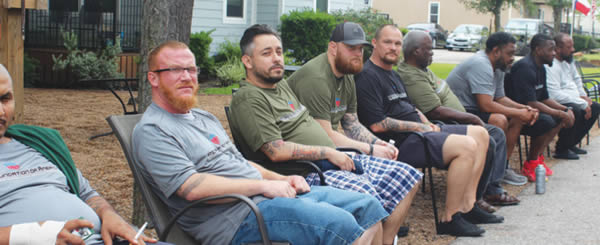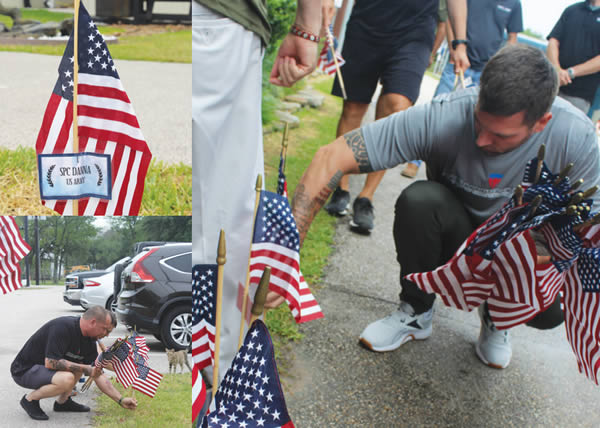
Saving Veteran’s Lives
An interview with David Maulsby, executive director of the PTSD Foundation of America and driving force behind creation of Camp Hope.
STORY BY FRANK JARDIMPHOTOS BY CAMP HOPE

who return suffer from what was once known
as “shell shock” or “combat fatigue” but is now
classified as PTSD and talked about far more
openly. Camp Hope offers free treatment.
As a kid, seeing the old men at the Memorial Day parade with the sleeve of their coat or the leg of their suit pants pinned up because they were missing an arm or leg made a powerful impression on me. As I got older, I realized they were veterans of the First World War, the youngest of whom were in their late 70s in 1975. When I saw them, honoring their dead comrades whose names were cast into a bronze plaque on a monument in our town, it made me sad thinking how much harder their lives were because of
those terrible wounds. The experience helped me begin to see the real cost of war in the sacrifices that were made by real people. It was obvious even to a kid. As obvious as a veteran’s empty coat sleeve or wheelchair.
It wasn’t until I was an adult that I began to understand that many veterans suffered from grievous wounds that never earned them a Purple Heart like those whose bodies were torn by bullets and
explosions from shells and bombs.
Post-traumatic stress disorder, or PTSD, is estimated to effect up to 30 percent of military personnel to some degree. The American Psychiatric Association defines PTSD as, “a psychiatric disorder that may occur in people who have experienced or witnessed a traumatic event such as a natural disaster, a serious accident, a terrorist act, war/combat, or rape or who have been threatened with death, sexual violence or serious injury.” PTSD doesn’t just affect veterans.
People suffering from PTSD often have intense, disturbing thoughts and feelings related to their experiences that last long after those traumatic experiences have ended. Reliving the experiences through flashbacks or nightmares is common, as are feelings of sadness, fear and anger. The symptoms can leave the sufferer feeling detached or estranged from family and friends, and isolated from people in general. People with PTSD often try to avoid situations or people that remind them of their traumatic experiences, and they may have strong negative reactions to something as ordinary as a loud noise or an unexpected touch.
While PTSD among combat veterans is nothing new to the military medical community, the treatment of it outside of active duty is a rather recent development. In World War I, PTSD symptoms were grouped under the term “shell shock,” and in World War II it was called “combat fatigue.”
Its immediate debilitating effects were recognized and treatments attempted to restore the mentally injured soldier to combat effectiveness so he could be returned to his unit and resume his military duties. Whatever mental troubles he may carry home with him after discharge were apparently seen by the military as a private, personal matter outside the interest or responsibility of the government. The
proliferation of Veterans of Foreign Wars and American Legion clubs across America after the world wars may have been a grass-roots, private sector solution for veterans to at least partially mitigate their PTSD. While the understanding company of fellow veterans probably helped, the fact that all these clubs were essentially private bars certainly hurt those vets inclined to self-medicate with alcohol. My uncle was one of the latter.
An infantryman in Europe in WWII, he came home in 1945 a different man. PTSD derailed his promising prewar future. He never married, had trouble holding down a job, lived in poverty and ultimately drank himself to death alone in a run-down apartment. What happened to my uncle was a terrible waste. He
loved his kin, and at least they loved him back. They clearly thought more of him than he did of himself. As I got older, I started to recognize my uncle in other veterans. Jumping to the present, the cost of failing to adequately treat PTSD among service members and veterans is becoming shockingly apparent to
more and more Americans.
For me it happened a few years ago, when an acquaintance who worked for the Department of Defense at Fort Knox (a man in a position to know) told me that active-duty military personnel were committing suicide in increasing numbers. To my disbelief, he informed me that every day, some soldier, sailor, marine or airman killed themselves. Just that week, a young soldier, recently returned from a deployment in Afghanistan and living in the pleasant, suburban-like on-post housing, got into a seemingly inconsequential argument with his wife and afterwards walked out the door, put a gun to his head and killed himself in the front yard.

Day, the federal holiday that honors soldiers,
sailors, marines, airmen and others who died
fighting in the country’s wars.
By the end of 2018, the official reporting showed 321 active-duty military suicides for the year, but when the Reserve and National Guard components were added in, the deaths rose to 584. Since then, the reported suicide deaths indicate things haven’t really improved.
They’ve actually gotten worse overall. Suicides weren’t tracked before 2001, so we don’t have a concise picture of how things were in pre-9/11 wars, but the fact is the increasing suicide rate has alarmed leadership in the military and Department of Veterans Affairs. As heartbreaking as this trend is, it pales in comparison to the rising suicide rate of post-9/11 discharged veterans. Last September, an official study reported that in the 20 years from 2001 to 2021, 30,177 active-duty personnel and Iraq/Afghanistan
veterans died by suicide. In the same period, only 7,057 service members were killed in combat. You read that right! Four times as many active-duty and veteran military personnel who served in Iraq and Afghanistan died by their own hand than were killed by the enemy in combat operations.



